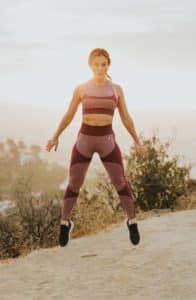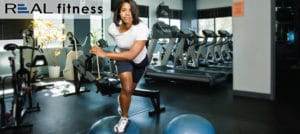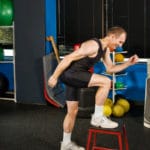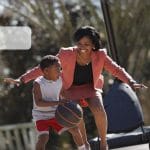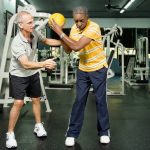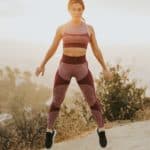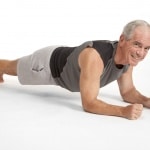 March 2024
March 2024
Can Weight Vests Answer All Your Fitness Needs?
Weight vests (WV) getting some media attention. These are either fixed or adjustable velcro-fitted vests that presumably enhance one or more elements of fitness and wellness training. A deep-dive into the science of WV reveals some benefits worth considering.
For example, a study in Rheumatology International (Feb. 2013) compared 2 groups of postmenopausal women doing 30 min/day, 3 d/wk of treadmill walking with or without a WV (4-8% bodyweight). They found, after 6 weeks, that a partial tandem stance balance test improved among WV-wearers but not among the controls. They also had more fat decrease and muscle-mass increases than the controls. Both groups got similar bone synthesis and bone resorption effects.
A Journal of Orthopedic and Sports Physical Therapy (Feb. 2015) study found that a 6-month weight-bearing cardio program while wearing a WV for women with low bone mineral density(BMD) – osteopenia or osteoporosis – was feasible, with good adherence and low dropout rates. And it improved quadriceps strength and bone density at the femoral trochanter, where breaks tend to occur. Even dynamic balance improved.
Finally, a 32-week, thrice weekly/year jumping program done over a 5-year period while wearing a WV enhanced bone density at the hips more than those in the control group who didn’t wear a WV. Again, there was good adherence with no injuries. BMD increased at the femoral neck, hip trochanter, and total hip due to the intervention while the controls lost bone density at all sites. (Journals of Gerontology: Series A: Biological Sciences & Medical Sciences, Sept. 2000)
So it might be time to IN-vest….
Balance Training Timing: Pre- or Post-Fatigue?
In the strength and conditioning world, there are many arguments as to when to implement specialized training such as balance. This is a topic we’ve covered here, here, and here, so it’s worth keeping an eye on our site for updates to this critical piece of fitness. Some contend that it’s best to train according to when one is most apt to hurt oneself while being active, that is, after one is somewhat fatigued. Others posit that it’s best to train the neuromuscular system, of which balance is a part, while it is fresh and unimpeded by metabolic and psychologic stressors that exercise fatigue brings. The research on this is scant but a Swiss study attempted to resolve the matter by having 3 groups of healthy, active participants train 2/wk on various balance devices – cushioned pads, air-filled disks, etc. – in various states of inputs – both eyes open, multi-tasked (tossing a ball), or eyes closed (obviously not playing catch with a ball!)
One group served as the controls and just did balance training (BT); another did BT followed by high-intensity training (BT+HIT) while another did HIT first followed by BT (HIT+BT). The hypothesis was that HIT+BT would adapt by improving balance while fatigued and that the BT and the BT+HIT groups would improve balance in a rested state but not in a fatigued state.
Sometimes science does not prove the obvious. In this case, the BT and BT+HIT groups fared well in the rested states, as expected, but the HIT+BT group did not fare as well in either state: “balance training under fatigue results in diminished improvements in postural sway compared with balance training in an unfatigued state, both when tested in the unfatigued and in fatigued states.” So do balance drills safely, rested, most of the time.
JSCR Feb. 2024
Tid Bits
This just in: TV watching is bad for you. The Raine Study followed participants from the time they were 5 until they were 20, assessing TV habits over that time. They were categorized as Low (<14 hr/wk), High (>14 hr/wk), and Increasing (changing from Low to High) watchers. At age 28, 560 agreed to have arterial function tests. “TV watching behaviours during childhood and adolescence may have legacy impacts on artery function at age 28 yrs, particularly in females.” MSSE Sept. 2023
The patellar tendon (that runs from the kneecap to the front of the shin) is a source of pain and discomfort for many an athlete. Physical therapy science is struggling to determine what exercises are best to prevent and treat this injury site. A study in the March 2024 issue of MSSE tested the loading index of 35 rehab exercises and categorized them into 3 tiers. Tier 3, the hardest, include the one-leg decline squat and one-leg forward hop as 2 of the most strenuous. The Spanish/Sissy squat, running, and the one-leg full squat headline tier 2. And shallow step ups or step downs are two of Tier 1 exercises.
Half of all exercisers don’t understand what it’s like to wear a tight-fitting wrap around their chests while trying to exert themselves vigorously. But women do. A study compared 3 different sports bras on the respiratory function and mechanical work of 9 highly trained female runners. While running at maximal and sub-maximal intensities, wearing a loose, a self-selected or a tight underband sports bra, they found significantly greater work and a 5% greater minute ventilation rate wearing the tight vs the loose bra at max intensity. At submax intensity, there was a 1.3% increase in the O2 cost of running in the tight bra. In both conditions, breath frequency was lower in a looser bra. However, a balance between excessive breast motion and respiratory discomfort needs to be achieved to keep women in the game. MSSE Feb. 2024

 March 2024
March 2024